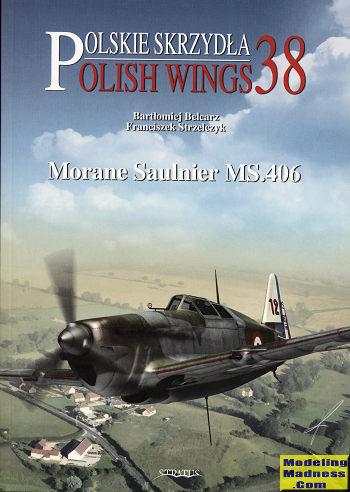 The MS.406 was
France's first large production modern fighter and was the fighter that was used
in the greatest numbers at the start of WWII. It would be appropriate to compare
it with the Hawker Hurricane. Both were steel tube construction mostly covered
with fabric. Both used liquid cooled engines of similar horsepower. Both were
the first modern fighter used by the two services with enclosed canopy,
retractable landing gear and low wing monoplane design. However, the MS.406 was
armed differently using a motor cannon along with a pair of wing machine guns.
The MS.406 was
France's first large production modern fighter and was the fighter that was used
in the greatest numbers at the start of WWII. It would be appropriate to compare
it with the Hawker Hurricane. Both were steel tube construction mostly covered
with fabric. Both used liquid cooled engines of similar horsepower. Both were
the first modern fighter used by the two services with enclosed canopy,
retractable landing gear and low wing monoplane design. However, the MS.406 was
armed differently using a motor cannon along with a pair of wing machine guns.
Though France did field some more modern types like the
Dewoitine D.520, those were not built in great numbers and many were still
awaiting parts to fully complete the airframes by the time the Germans invaded
in May 1940. So how is this aircraft part of the Polish Wings series, you may
ask. Well, after Poland was defeated by the Germans and Soviets, many of their
pilots and other military personnel fled to France, where it was hoped they
would be able to reestablish a government in exile. This included getting the
weapons with which to fight and one of those was the MS.406.
The Poles did not want their pilots and ground crew
disseminated into French units and wanted to remain somewhat autonomous within
the French military structure. As such, the MS.406s were purchased for use, with
the French providing training support. While many were able to see combat and
some has some success, the majority were still undergoing training on the type
when the French signed the armistice.
This book covers as much as it can, every aircraft flown
by Polish pilots. Those bought sported Polish insignia on the fuselage. Others
were with French units and so had standard insignia. A few things I learned from
this book were that there were several general patterns for the camouflage. Now
while all the schemes were very individualistic, some were more compact than
others depending on where the plane was built or overhauled. I also found that a
fair number of aircraft had a thin red stripe along the leading edge of the wing
as shown in the cover art. As with others in this series, the research is first
rate. Also in line with previous volumes is that most of the book consists of
large full color profiles based on photos of the actual aircraft, making this an exceptionally image intensive volume. This particular edition is entirely in English, which is
important for most readers. Another excellent book in the series and one that I
know you will like.
May 2024
Copyright ModelingMadness.com. All rights reserved. No
reproduction in part or in whole without express permission.
Review book courtesy of
Casemate Publishers. You can get yours direct from
this link.
If you would like your product reviewed fairly and quickly , please
contact the editor or see other details in the Note to
Contributors.
 The MS.406 was
France's first large production modern fighter and was the fighter that was used
in the greatest numbers at the start of WWII. It would be appropriate to compare
it with the Hawker Hurricane. Both were steel tube construction mostly covered
with fabric. Both used liquid cooled engines of similar horsepower. Both were
the first modern fighter used by the two services with enclosed canopy,
retractable landing gear and low wing monoplane design. However, the MS.406 was
armed differently using a motor cannon along with a pair of wing machine guns.
The MS.406 was
France's first large production modern fighter and was the fighter that was used
in the greatest numbers at the start of WWII. It would be appropriate to compare
it with the Hawker Hurricane. Both were steel tube construction mostly covered
with fabric. Both used liquid cooled engines of similar horsepower. Both were
the first modern fighter used by the two services with enclosed canopy,
retractable landing gear and low wing monoplane design. However, the MS.406 was
armed differently using a motor cannon along with a pair of wing machine guns.